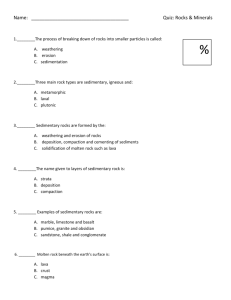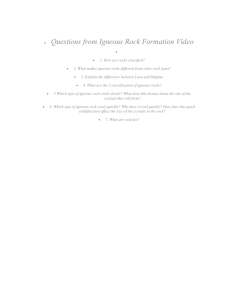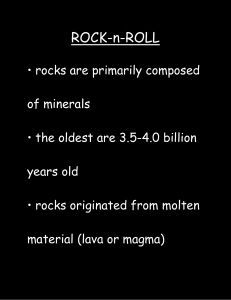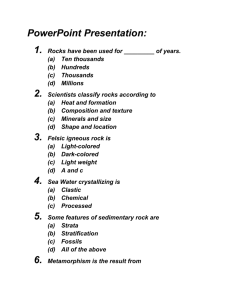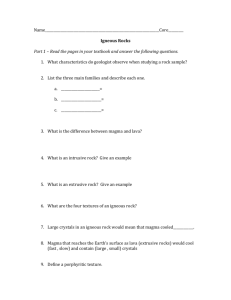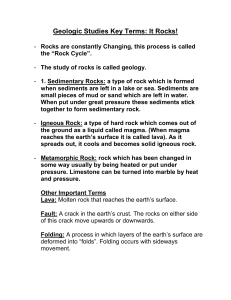Geology – EXAM-1 Fall-2009
advertisement
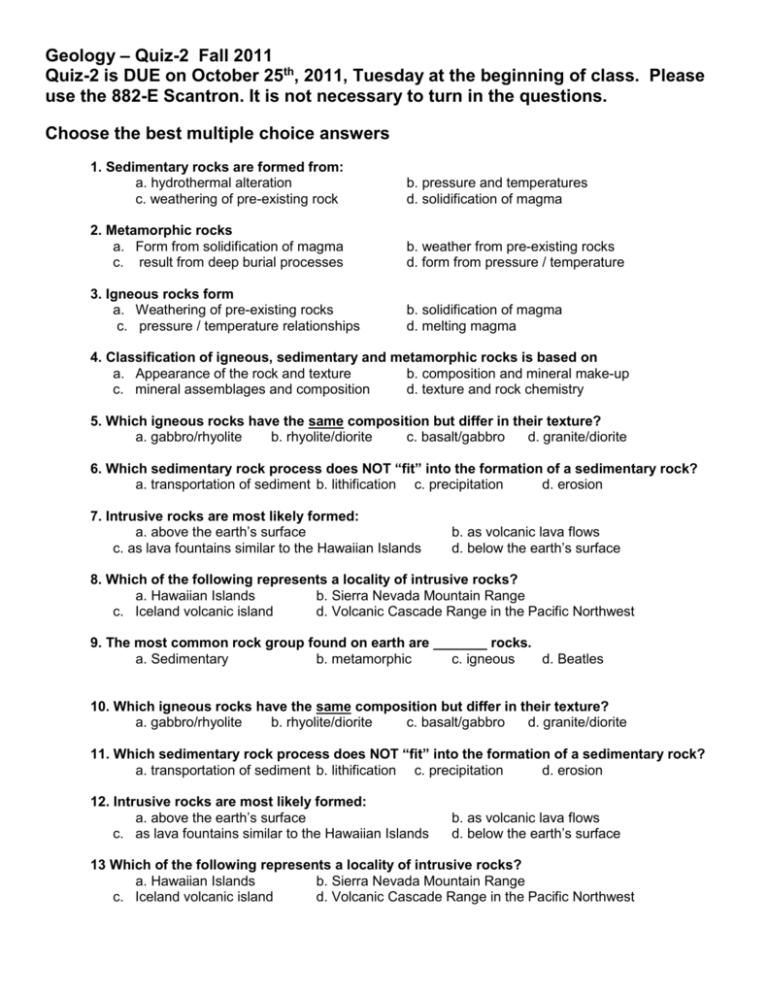
Geology – Quiz-2 Fall 2011 Quiz-2 is DUE on October 25th, 2011, Tuesday at the beginning of class. Please use the 882-E Scantron. It is not necessary to turn in the questions. Choose the best multiple choice answers 1. Sedimentary rocks are formed from: a. hydrothermal alteration c. weathering of pre-existing rock b. pressure and temperatures d. solidification of magma 2. Metamorphic rocks a. Form from solidification of magma c. result from deep burial processes b. weather from pre-existing rocks d. form from pressure / temperature 3. Igneous rocks form a. Weathering of pre-existing rocks c. pressure / temperature relationships b. solidification of magma d. melting magma 4. Classification of igneous, sedimentary and metamorphic rocks is based on a. Appearance of the rock and texture b. composition and mineral make-up c. mineral assemblages and composition d. texture and rock chemistry 5. Which igneous rocks have the same composition but differ in their texture? a. gabbro/rhyolite b. rhyolite/diorite c. basalt/gabbro d. granite/diorite 6. Which sedimentary rock process does NOT “fit” into the formation of a sedimentary rock? a. transportation of sediment b. lithification c. precipitation d. erosion 7. Intrusive rocks are most likely formed: a. above the earth’s surface c. as lava fountains similar to the Hawaiian Islands b. as volcanic lava flows d. below the earth’s surface 8. Which of the following represents a locality of intrusive rocks? a. Hawaiian Islands b. Sierra Nevada Mountain Range c. Iceland volcanic island d. Volcanic Cascade Range in the Pacific Northwest 9. The most common rock group found on earth are _______ rocks. a. Sedimentary b. metamorphic c. igneous d. Beatles 10. Which igneous rocks have the same composition but differ in their texture? a. gabbro/rhyolite b. rhyolite/diorite c. basalt/gabbro d. granite/diorite 11. Which sedimentary rock process does NOT “fit” into the formation of a sedimentary rock? a. transportation of sediment b. lithification c. precipitation d. erosion 12. Intrusive rocks are most likely formed: a. above the earth’s surface c. as lava fountains similar to the Hawaiian Islands b. as volcanic lava flows d. below the earth’s surface 13 Which of the following represents a locality of intrusive rocks? a. Hawaiian Islands b. Sierra Nevada Mountain Range c. Iceland volcanic island d. Volcanic Cascade Range in the Pacific Northwest 14. The most common rock group found on earth are _______ rocks. a. Sedimentary b. metamorphic c. igneous d. Beatles 15. Which of the following sedimentary rock types would form within a lake type environment? a. conglomerate b. shale c. coarse-grained sandstone d. granite 16. Clastic type rocks are ________ rocks that are chiefly composed of __________. a. metamorphic / minerals b. igneous / quartz c. sedimentary / fossils d. sedimentary / inorganic particles 17. A sandstone is an example of a (an) ___________ rock. a. igneous b. mineralogic c. sedimentary d. metamorphic 18. Which of the following statements regarding igneous rocks is not true? a. Extrusive rocks have larger crystals than intrusive rocks. b. Extrusive rocks cool more rapidly than intrusive rocks. c. Igneous rocks originate deep in the crust or upper mantle. d. Igneous rocks from by crystallization of magma. 19. Pore fluids enhance metamorphism by ______ a. permitting material to dissolve b. permitting chemical components to move around and be precipitated somewhere else c. speeding up some chemical reactions d. All of the above statements are correct 20. Which of the following minerals is not commonly found in igneous rocks? a. quartz b. feldspar c. olivine d. calcite 21. Clastic sediments form from _____________ a. raid cooling of molten sediments b. physically deposited particles of sediment c. precipitation of sediments from sea water d. accumulation of calcium carbonate shells 22. A typical basalt consists of approximately 50% __________. a. Al2O3 b. FeO c. CaO d. SiO2 23. Where does the rock cycle start? a. crystallization of molten magma b. deposition of sediment c. metamorphism d. there is no “start” – all rocks form from preexisting rocks 24. Which of the following processes is not involved in lithification? a. cementation b. compaction c. metamorphism d. a,b,c are all involved 25. Lithified pea-sized clastic grains (greater than 2mm) produce _____ type rocks a. conglomerate b. sandstone c. coquina d. limestone 26. Typical evaporite sedimentary rocks are the result of a. chemically saturated water that has been evaporated b. deposition c. running water that has been evaporated d. solid-state transformations 27. Precipitation of chemical rocks takes place in two ways a. plants and animals alter the chemical balance of the water and/or chemical rocks are evaporated in chemically saturated water b. transportation of inorganic sediment and lithification processes c. the accumulation of plant material and fossilizing animal parts d. solidification of molten magma and deposition of chemically saturated material. 28. Hot dense gaseous clouds that stream at 125 km/hr down the flanks of a composite cone volcanoes are known as a. nuee ardant clouds b. pyroclastic clouds c. atmospheric cloud bursts d. hot flashes 29. Large mudflows composed of large rocks, water and mud moving down a pre-existing stream valley are known as a. lahars b. pyroclastic eruptions that emanate from the caldera c. hot dense gas clouds d.large deposits of ash and rhyolitic tuff 30. Cinder cones have a. steep flanks ranging from 30-50 degrees angles b. very low angle flanks less than 10 degrees c. typical lava compositions similar to limestone d. layered ash and lava that build the low angled flanks 31. SiO2 concentration and temperature affects the ________of a volcanic eruption a. thickness and temperature b. pressure and chemical composition c. viscosity d. the concentration of solidified rock fragments within the lava 32. A volcano that is high in silica with low a low mafic composition produces a. a volcano that low in silica b. a volcano that has high viscosity and composed of basalt c. a volcano that is 25% silica and high in iron and magnesium d. explosive type volcanoes 33. The most abundant volatile erupted from a typical volcano is a. SiO2 b. Carbon dioxide c. Methane d. Water vapor 34. Volcanoes that have broad and low angle flanks and chiefly composed of basaltic lava are a. Composite type volcanoes b. Shield type volcanoes c. Cinder cone type volcanoes d. Stratcompoite type volcanoes 35. The ring of fire is represents a. volcanic and earthquake activity at the San Andreas Fault zone b. volcanic and earthquake activity around the Pacific plate boundary c. the site of volcanic activity within the Hawaiian Islands d. The famous song by Johnny Cash 36. Mount St Helens is considered a (an) a. composite volcano and part of the Cascade Mountain range b. explosive volcano with high silica content and high viscosity magma c. volcano possessing pyroclastic ejecta and occasional lahars d. all of the above 37. Which of the following is/are most susceptible to chemical weathering by dissolution? a. quartz b. clay minerals c. iron oxides d. calcite 38. Clay minerals, silica (SiO2), and dissolved potassium bicarbonate in the soil water are products of which process? a. chemical weathering of olivine and plagioclase feldspar b. mechanical weathering of granite and rhyolite c. chemical weathering of orthoclase feldspar d. differential mechanical weathering of micas 39. What two factors speed up rates of chemical reaction and weathering in rocks and soils? A) low temperatures; very dry B) low temperatures; very moist C) high temperatures; very dry D) warm temperatures; very moist 40. In which area are pedocal soils most likely to be found? A) a tropical rainforest in the Amazon Basin of Brazil B) a bitterly cold, permafrost area in north-central Siberia C) a forested area of the southeastern United States D) a moderately dry to semiarid grassland such as the western Great Plains 41. Which one of the following is an important, mechanical weathering process for enlarging fractures and extending them deeper into large boulders and bedrock? A) oxidation B) eluviations C) hydrologic cycling D) frost wedging 42. What two chemical constituents cannot form by chemical weathering of the feldspar minerals? A) soluble sodium and potassium bicarbonates B) insoluble iron oxides and soluble magnesium bicarbonates C) silica and insoluble clay minerals D) silica and soluble calcium bicarbonate 43. Which one of the following statements concerning mechanical weathering is not true? A) reduces grain sizes of rock particles B) allows for faster rates of chemical weathering C) is important in the formation of talus slopes D) involves a major change in the mineral composition of the weathered material 44. Which term describes a soil formed by weathering of the underlying bedrock? A) transformational B) residual C) relict D) transported 45. Which one of the following statements best describes erosion? A) disintegration and decomposition of rocks and minerals at the surface B) movement of weathered rock and regolith toward the base of a slope C) the process by which weathered rock and mineral particles are removed from one area and transported elsewhere D) the combined processes of leaching, eluviation, and mass wasting 46. Lava flows are typically finer grained than intrusive igneous rocks. Why? A) Intrusive magma is cooler because it is well insulated by the surrounding rock. B) Intrusive magma flows onto the Earth's surface and cools very slowly, allowing many small mineral grains to grow. C) The extrusive magma cools quickly so the mineral grains do not have time to grow. D) The extrusive magma, because it is deep below the surface, cools very slowly producing very small mineral grains. 47. Consider the Bowen's reaction series. Which mineral would you expect to see as a phenocryst in a porphyritic basalt? A) olivine B) quartz C) orthoclase D) sodium-rich plagioclase 48. Which of the following igneous rocks exhibit aphanitic texture? A) granite; gabbro B) andesite; rhyolite C) andesite; diorite D) rhyolite; gabbro 49. Visible quartz and potassium feldspar grains are the main constituents in a ________. A) granite B) gabbro C) basalt D) rhyolite 50. Which of the following igneous rocks has a pyroclastic texture? A) rhyolitic tuff B) porphyritic basalt C) intrusive granite D) andesitic lava 51. ________ is a volcanic rock that is extremely vesicular and glassy. A) Obsidian B) Pegmatite C) Tuff D) Pumice 52. A (an) ________ texture represents a single, long period of cooling and crystallization. A) glassy B) pyroclastic C) aphanitic D) phaneritic 53. Which of the following best describes an aphanitic texture? A) The rock is crystalline; mineral grains are too small to be visible without a magnifying lens or microscope. B) The mineral grains have glassy textures. C) The rock consists of broken, volcanic-rock and mineral fragments. D) The rock is crystalline; mineral grains are of distinctly different sizes 54. ________ is the dominant lava erupted from volcanoes on Hawaii and Iceland. A) Rhyolite B) Andesite C) Peridotite D) Basalt 55. In 1980, ________ was the first Cascade Range volcano to erupt since Mt. Lassen, California, in 1915-16. A) Mt. Rainier B) Mt. Shasta C) Kilauea D) Mt. St. Helens 56. Which type of basaltic lava flow has a fairly smooth, unfragmented, ropy surface? A) aa B) pegmatitic C) pahoehoe D) scoria 57. ________ is a major dissolved volatile constituent in both magmas and volcanic gases. A) Water B) Carbon monoxide C) Hydrogen chloride D) Methane 58. ________ magma is the most abundant type of magma erupted at oceanic spreading centers. A) Basaltic B) Granitic C) Andesitic D) Pegmatitic 59. The ________ ocean basin is rimmed by the most subduction zones. A) Atlantic B) Indian C) Pacific D) Arctic 60. Why would a plume of solid silicate rock rising slowly from deep in the mantle begin melting as it neared the base of the lithosphere? A) The rock heats up and expands at lower pressures, causing it to liquefy. B) Temperatures remain high as lowered pressures decrease melting temperatures. C) The lowered pressures cause rapid heat loss accompanied by melting. D) none of the above 61. Which statement about the May, 1980, eruption of Mount St. Helens is false? A) During the eruptive period, the mountain peak was substantially built up by new lava flows and pyroclastic debris. B) Plumes of ash rose high into the atmosphere during the major eruptive events. C) Mudflows accompanied the major eruptive events. D) The most powerful explosive event was preceded by a massive landslide 62. ________ tend to increase the explosive potential of a magma body beneath a volcano. A) High viscosity and dissolved gas B) High viscosity; low dissolved gas content C) Low silica content, low viscosity D) Low viscosity; low dissolved gas content 63. Which type of basaltic lava flow has its surface covered with sharp-edged, angular blocks and rubble? A) scoria B) pahoehoe C) pillow lava D) aa 64. Which one of the following statements concerning cinder cones is false? A) They are small volcanoes with fairly steep sides. B) They are built mostly or entirely during one eruptive cycle. C) The cinders and other pyroclastic particles are consolidated into welded tuff. D) The cinders most commonly are basaltic. 65. The Columbia Plateau in Washington and Oregon is ________. A) a flood basalt plateau B) a thick stack of welded-tuff layers C) a caldera filled with rhyolite lava flow. D) a field of large stratovolcanoes 66. Which kind of eruptive activity is most likely to be highly explosive? A) Lava flows from a large shield volcano on an oceanic island. B) Fissure eruptions feeding lava to flood basalt accumulations. C) Eruptions of big, continental margin, composite cones or stratovolcanoes. D) Lava flows from a large cinder cone complex. 67. Which kind of volcanism is typical of mid-oceanic ridge systems? A) explosive; composite cones B) submarine; basaltic lava flows C) fissure eruptions; flood basalts fields D) explosive; rhyolitic, pyroclastic flows 68. Which of the following best describes Shiprock, a famous volcanic feature in New Mexico? A) a very recently active, basaltic cinder cone B) an extinct, highly symmetrical, composite volcanic cone C) the eroded remains of a volcanic pipe and radiating dikes D) an extinct, massive, rhyolitic shield volcano 69. Which one of the following best describes volcanism in the Cascade Range, northwestern United States? A) related to a mantle hot spot B) related to plate subduction C) related to a mid-oceanic ridge system D) related to deep, transform faults 70. Which one of the following shows the correct order (left to right) of decreasing magma viscosity? A) rhyolite, andesite, basalt B) andesite, rhyolite, basalt C) basalt, rhyolite, andesite D) basalt, andesite, rhyolite 71. Why do magmas rise toward Earth's surface? A) Magmas are more viscous than solid rocks in the crust and upper mantle. B) Most magmas are richer in silica than most crustal and upper mantle rocks. C) Magmas are mainly liquid and contain dissolved fluids such as water; most are less dense than the adjacent solid rock. D) all of the above 72. A ________ is an intrusive, igneous rock body that is tabular and concordant. A) laccolith B) dike C) pluton D) sill 73. A ________ is a near surface, intrusive, igneous rock body that results from local inflation of a horizontal sill. A) batholiths B) dike C) laccolith D) volcanic neck 74. Which of the following best describes the bedrock in the Sierra Nevada Mountains in California? A) basalt; dikes B) gabbro; plutoliths C) andesite; laccoliths D) granite; batholiths 75. Which of the following forms at the highest grade of regional metamorphism? A) hornfels B) schist C) slate D) phyllite 76. ________ is a strong, parallel alignment of coarse mica flakes and/or of different mineral bands in a metamorphic rock. A) Rock cleavage B) Foliation C) Stress streaking D) Marbleizing 77. Which of the following best describes the conditions of contact metamorphism? A) Pressures are very high, the rock is deeply buried, and temperatures are raised by the Earth's internal heat. B) Pressures are fairly low, the rock is in the upper part of the crust, and heat is supplied from a nearby magma body. C) Heat is generated by shearing and mechanical movements along faults. D) Depths are fairly shallow, but temperatures and pressures are so high that the rocks begin to partially melt. 78. ________ forms from the metamorphism of limestone or dolostone. A) Migmatite B) Amphibolite C) Marble D) Quartzite 79. ________ is characterized by the segregation of light- and dark-colored minerals into thin layers or bands. A) Garnet hornfels B) Granitic gneiss C) Slate D) Quartzite 80. ________ is typically formed by metamorphism of a sandstone. A) Marble B) Slate C) Amphibolite D) Quartzite 81. What is the major source of heat for contact metamorphism? A) deep burial and heat from the Earth's interior B) heat from grinding and shearing on faults C) heat from the spontaneous decomposition of micas and feldspars D) heat from a nearby magma body 82. In which setting would regional metamorphism be most likely? A) at shallow depths below an oceanic ridge or rift zone B) at shallow depths along major transform faults in the continental crust C) at great depths in the crust where two continents are colliding D) at shallow depths beneath the seafloor where water pressures are immense 83. A ________ forms at very high pressures but moderately low temperatures associated with subduction of oceanic crust and sediments. A) mylonite B) migmatite C) biotite marble D) blueschist

